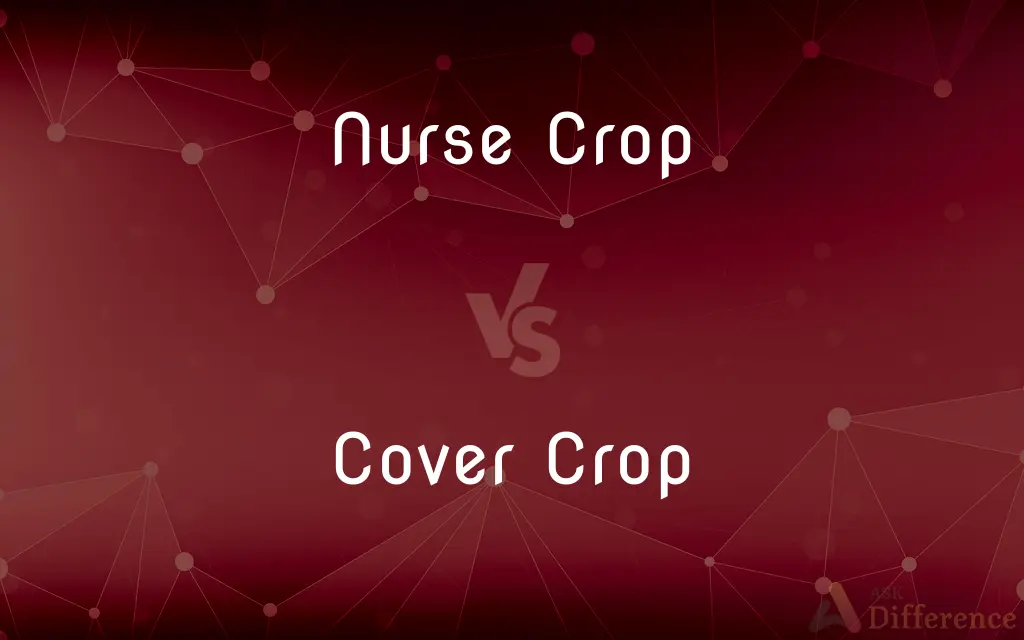Nurse Crop vs. Cover Crop — What's the Difference?
By Maham Liaqat & Fiza Rafique — Published on July 19, 2024
A nurse crop is planted to protect and support the growth of a main crop, often by providing shade or reducing weed competition, while a cover crop is grown primarily to improve soil health, prevent erosion, and manage weeds, pests, and diseases.

Difference Between Nurse Crop and Cover Crop
Table of Contents
ADVERTISEMENT
Key Differences
Nurse crops serve as a temporary protective canopy for slower-growing primary crops, such as trees or perennial plants, safeguarding them from excessive sun, wind, or the competitive pressure of weeds. On the other hand, cover crops, which can include legumes, grasses, and other green plants, are utilized not for the benefit of a specific main crop but to enhance the overall soil structure, fertility, and quality, as well as to manage agricultural pests and diseases more sustainably.
While the concept of a nurse crop is closely tied to the establishment and success of a subsequent main crop, cover crops may not directly support a specific subsequent crop but rather contribute to the long-term health and sustainability of the agricultural system. Nurse crops are often removed once their protective role is no longer needed, either through harvest or termination, allowing the main crop to flourish without competition. Conversely, cover crops are typically incorporated back into the soil or left to decompose, providing organic matter and nutrients that improve soil health and structure.
The selection of a nurse crop depends on its compatibility with the main crop, including its growth rate, height, and method of removal. This ensures the nurse crop provides protection without becoming a competitive threat. Cover crops are selected based on the desired soil improvement outcomes, such as nitrogen fixation, erosion control, or weed suppression, with different species providing different benefits to the soil and subsequent crops.
Nurse crops are particularly beneficial in forestry and the establishment of perennial gardens or agricultural fields, where they can significantly reduce the initial establishment costs and increase the survival rate of seedlings. Cover crops play a critical role in crop rotation and no-till farming practices, contributing to the reduction of soil erosion, improvement of water retention, and suppression of weeds, ultimately leading to increased biodiversity and ecological benefits.
Both nurse crops and cover crops embody sustainable agricultural practices, but their roles differ in focus and timing. Nurse crops are temporary and aimed at the protection and establishment of another crop, while cover crops have a broader, more holistic role in improving soil health and ecosystem sustainability over time. Integrating both practices can lead to a more resilient and productive agricultural system.
ADVERTISEMENT
Comparison Chart
Primary Purpose
Protect and support the growth of main crop
Improve soil health, prevent erosion
Typical Use
Shade or reduce competition for main crops
Enhance soil structure, manage weeds and pests
Selection Criteria
Compatibility with main crop, easy termination
Desired soil benefits, such as nitrogen fixation
Removal Method
Harvested or terminated once main crop is established
Incorporated into soil or left to decompose
Benefits
Reduces weed competition, protects from elements
Improves soil fertility, reduces erosion, suppresses weeds
Common Examples
Oats, barley used with trees or perennials
Legumes, grasses used in crop rotation
Agricultural Role
Temporary, focused on a specific crop's early stages
Long-term, focused on overall soil and ecosystem health
Sustainability
Increases survival rate of main crops
Promotes biodiversity and reduces agricultural input needs
Compare with Definitions
Nurse Crop
A temporary crop planted to aid the establishment of a main crop.
Oats used as a nurse crop for newly planted tree seedlings.
Cover Crop
Helps in managing weeds and pests naturally.
Rye used as a cover crop to suppress weed growth.
Nurse Crop
Selected for easy removal to prevent competition.
Nurse crops are chosen for their compatibility and non-invasive growth.
Cover Crop
Plays a key role in sustainable farming practices.
Cover cropping in rotation systems promotes long-term soil health.
Nurse Crop
Protects young crops from environmental stresses.
Barley provides shade to young plants, reducing sun damage.
Cover Crop
Incorporated into the soil to enhance fertility.
Legume cover crops decompose, releasing valuable nutrients.
Nurse Crop
Often used in forestry and perennial plantations.
Nurse crops support the growth of slow-maturing orchard trees.
Cover Crop
Grown to improve soil health and biodiversity.
Clover as a cover crop fixes nitrogen, enriching soil.
Nurse Crop
Reduces establishment costs and increases survival rates.
Using a nurse crop in forestry to improve tree seedling success.
Cover Crop
Reduces soil erosion and improves water retention.
Grass cover crops stabilize soil and prevent runoff.
Common Curiosities
How does a cover crop benefit soil health?
It improves soil structure, fertility, and water retention while managing weeds and pests.
What is a nurse crop?
A temporary crop planted to protect and support the growth of a main crop during its early stages.
Can nurse crops become competitive with the main crop?
Yes, if not managed properly, but they are usually selected for easy removal to avoid competition.
What factors influence the selection of a cover crop?
Soil health goals, climate, and compatibility with the subsequent main crops.
Can the same plant be used as both a nurse and a cover crop?
Yes, depending on the agricultural context and objectives, some species can serve both purposes.
How do nurse crops protect young plants?
By providing shade, reducing weed competition, and protecting against wind or soil erosion.
Why are cover crops important in sustainable agriculture?
They reduce the need for chemical inputs, enhance biodiversity, and promote ecological balance.
How are nurse crops removed?
Through harvesting or termination, once they've served their protective role.
What is the main difference between a nurse crop and a cover crop?
Nurse crops are aimed at supporting a specific main crop, while cover crops focus on improving soil health and ecosystem sustainability.
What is the environmental impact of using cover crops?
Positive, as they enhance soil health, reduce erosion, and support biodiversity, leading to a more sustainable agricultural system.
Share Your Discovery

Previous Comparison
Soccer Boots vs. Football Boots
Next Comparison
Glucocorticoids vs. MineralocorticoidsAuthor Spotlight
Written by
Maham LiaqatCo-written by
Fiza RafiqueFiza Rafique is a skilled content writer at AskDifference.com, where she meticulously refines and enhances written pieces. Drawing from her vast editorial expertise, Fiza ensures clarity, accuracy, and precision in every article. Passionate about language, she continually seeks to elevate the quality of content for readers worldwide.














































